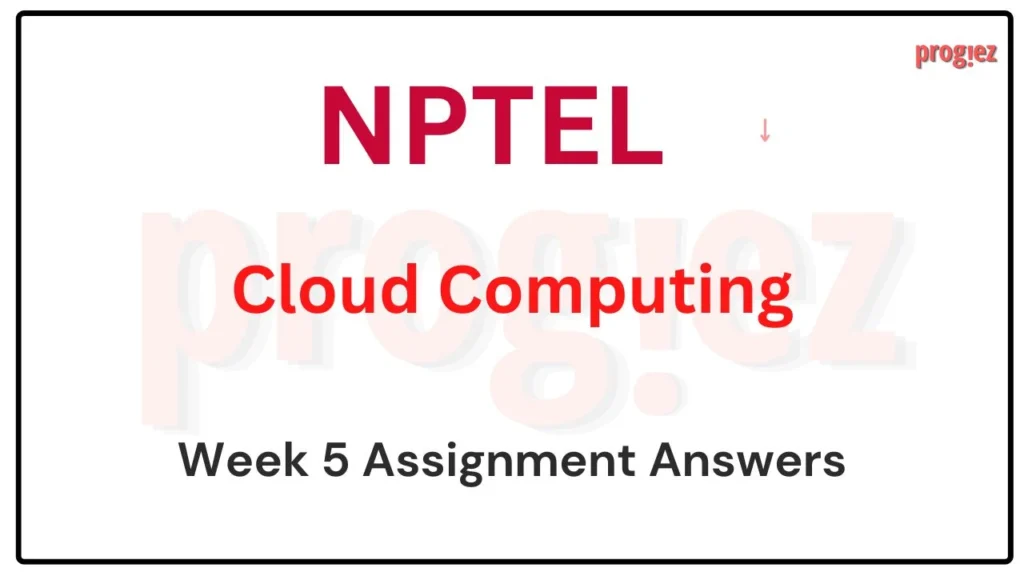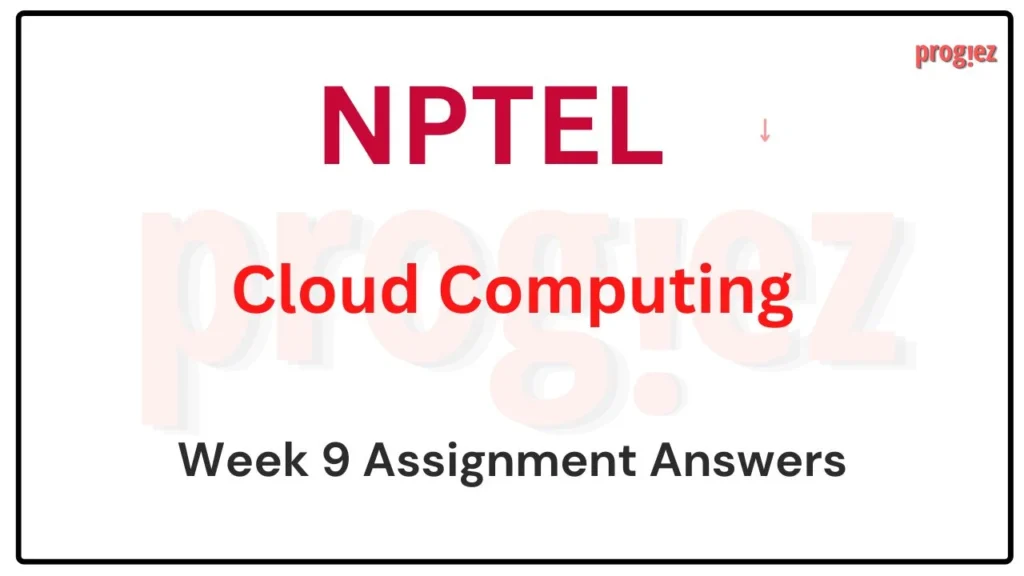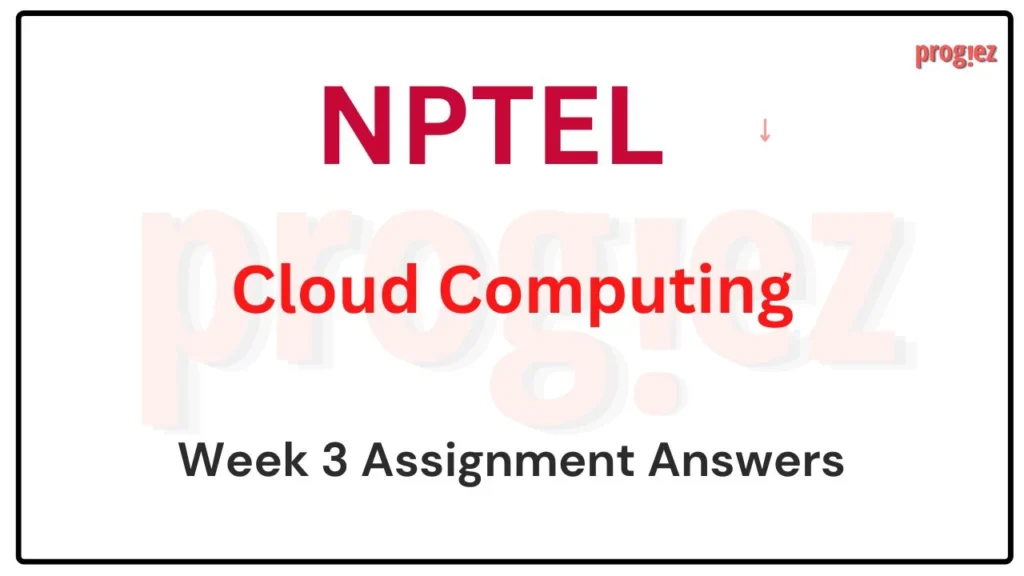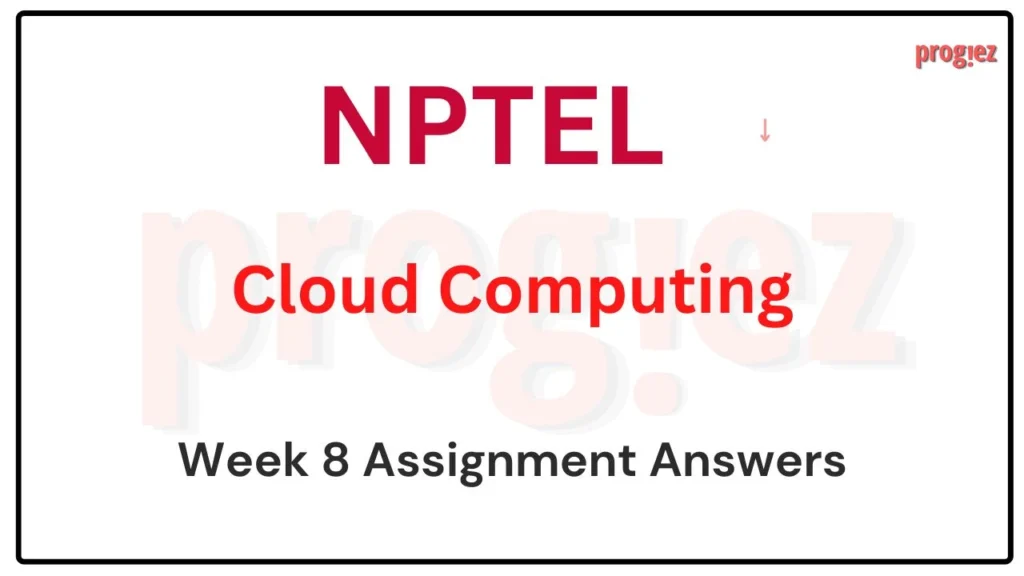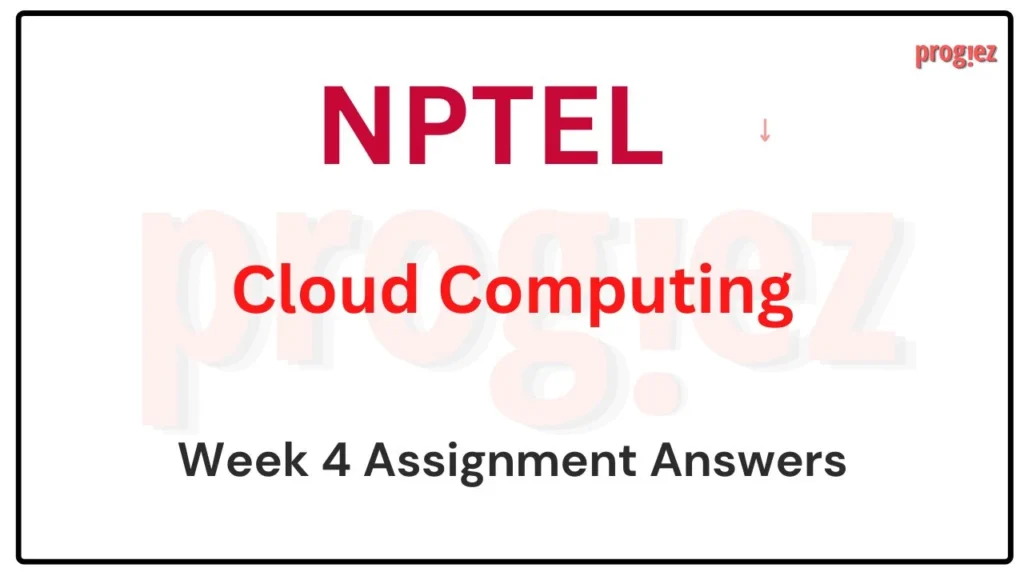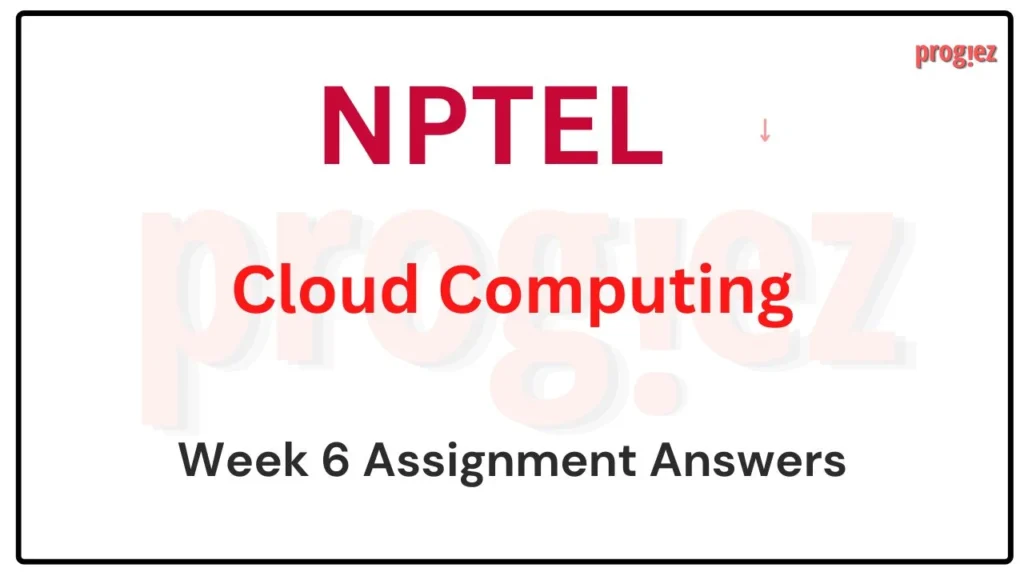Cloud Computing Nptel Week 7 Assignment Answers
Are you looking for the Cloud Computing Nptel Week 7 Assignment Answers Look no further! Our platform provides precise and comprehensive Cloud Computing Nptel Assignment Solutions for Week 7 in this course
Course Link: Click Here
Table of Contents
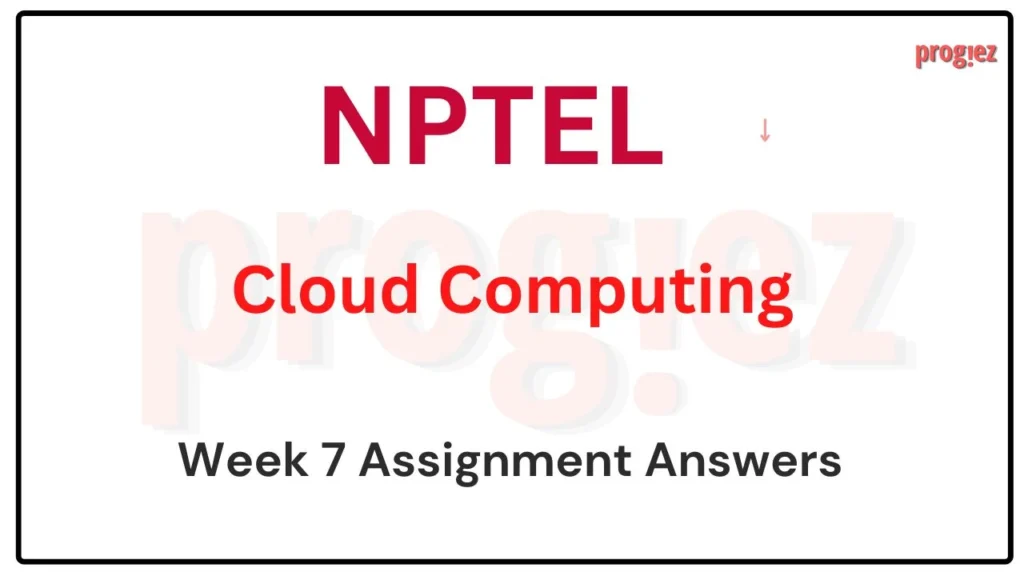
Cloud Computing Nptel Week 7 Assignment Answers (July-Dec 2024)
- The key features of mobile cloud computing (MCC) are
A) Facilitates the quick development, delivery and management of mobile apps
B) Uses more device resources because applications are cloud-supported
C) Improves reliability with information backed up and stored in the cloud
D) None of these
Answer: A) Facilitates the quick development, delivery and management of mobile apps
C) Improves reliability with information backed up and stored in the cloud
- Dynamic runtime offloading involves the issues of
A) Runtime application partitioning
B) Migration of intensive components
C) Continuous synchronization for the entire duration of runtime execution platform
D) None of these
Answer: A) Runtime application partitioning
B) Migration of intensive components
C) Continuous synchronization for the entire duration of runtime execution platform
- What is/are true about cloudlet?
A) Increases the latency in reaching the cloud servers
B) Reduces the latency in reaching the cloud servers
C) Resides far from the mobile devices
D) Resides near to the mobile devices
Answer: B) Reduces the latency in reaching the cloud servers
D) Resides near to the mobile devices
- What is/are true about mobile cloud computing (MCC)?
A) MCC increases the running cost for computation intensive applications
B) MCC reduces the running cost for computation intensive applications
C) MCC decreases battery lifetime
D) None of these
Answer: B) MCC reduces the running cost for computation intensive applications
- What is/are true about the execution of services in mobile cloud computing (MCC)?
A) All services are executed in cloud
B) Some services are executed in mobile devices and some services are executed in cloud
C) All computation intensive services are executed in mobile devices
D) None of these
Answer: B) Some services are executed in mobile devices and some services are executed in cloud
These are Cloud Computing Nptel Week 7 Assignment Answers
- What of the following is/are fog device(s)?
A) Cellular base stations
B) Network routers
C) WiFi Gateways
D) None of these
Answer: A) Cellular base stations
B) Network routers
C) WiFi Gateways
- What is/are the advantage(s) of fog computing?
A) Reduction in data movement across the network resulting in reduced congestion
B) Increase in data movement across the network resulting in increased congestion
C) Serving the real-time applications
D) None of these
Answer: A) Reduction in data movement across the network resulting in reduced congestion
C) Serving the real-time applications
- Consider the following statements:
Statement 1: In Geospatial Cloud, it is needed to integrate data from heterogeneous back-end data service.
Statement 2: Data services can be inside and/or outside of the cloud environment in Geospatial Cloud.
A) Statement 1 is Correct, but Statement 2 is Incorrect.
B) Statement 2 is Correct, but Statement 1 is Incorrect.
C) Both statements are Correct.
D) Both statements are Incorrect
Answer: C) Both statements are Correct.
- Which of the following statement(s) is/are FALSE about Fog Computing?
A) Fog nodes present near to the end-user
B) Fog computing enables real-time applications
C) Fog nodes’ response time is much higher than Cloud’s
D) Network routers, WiFi Gateways will not be capable of running applications
Answer: C) Fog nodes’ response time is much higher than Cloud’s
D) Network routers, WiFi Gateways will not be capable of running applications
- Which of the following is/are true about Geospatial Cloud Model?
A) It integrates data from homogeneous back-end data services
B) Data services can be inside and/or outside the cloud environment
C) Data services inside cloud can be run through SaaS service model
D) None of the above
Answer: B) Data services can be inside and/or outside the cloud environment
These are Cloud Computing Nptel Week 7 Assignment Answers
Cloud Computing NPTEL All weeks: Click Here
For answers to additional Nptel courses, please refer to this link: NPTEL Assignment Answers
Cloud Computing Nptel Week 7 Assignment Answers (JAN-APR 2024)
Course Name: Cloud Computing
Course Link: Click Here
For answers or latest updates join our telegram channel: Click here to join
These are Nptel Cloud Computing Assignment 7 Answers
Q1. Which of the following is/are key requirement(s) of Mobile Cloud Computing?
A) Simple APIs offering access to mobile services
B) Internet access to remotely stored applications in the cloud
C) Sophisticated APIs requiring knowledge of underlying network technologies
D) Web interface
Answer: A), B), D)
Q2. In Mobile Cloud Computing, the synchronizer module collects results of split execution and combines them, and makes the execution details transparent to the user.
A) TRUE
B) FALSE
Answer: A) TRUE
For answers or latest updates join our telegram channel: Click here to join
These are Nptel Cloud Computing Assignment 7 Answers
Q3. Geographical distribution of server nodes is Cloud Computing. in Fog Computing and in
A) Distributed, Centralized
B) Distributed, Distributed
C) Centralized, Distributed
D) Centralized, Centralized
Answer: A) Distributed, Centralized
Q4. Formulate the amount of energy saved (E) during offloading for the given data.
Energy cost/second while when mobile phone is doing computation = C1
Energy cost/second while when mobile phone is idle = C2
Energy cost/second while when mobile phone is transmitting the data = C3
Speed of cloud to compute k instructions = Sc
Speed of mobile to compute k instructions = Sm Data need to transmit = D
Bandwidth of the wireless Internet = B
A) E = C2(k/Sm) – C1(k/Sc) – C3(D/B)
B) E = C1(k/Sm) – C2(k/Sc) – C3(D/B)
C) E = C3(k/Sm) – C2(k/Sc) – C1(D/B)
D) E = C1(k/Sc) – C2(k/Sm) – C3(D/B)
Answer: B) E = C1(k/Sm) – C2(k/Sc) – C3(D/B)
For answers or latest updates join our telegram channel: Click here to join
These are Nptel Cloud Computing Assignment 7 Answers
Q5. Which of the following is/are not a benefit of Fog computing?
A) Location awareness
B) Higher latency as compared to cloud computing
C) Improved QoS
D) Man-in-the-middle-attack
Answer: B), D)
Q6. Population of a city/town is a static geographic information.
A)TRUE
B)FALSE
Answer: B)FALSE
For answers or latest updates join our telegram channel: Click here to join
These are Nptel Cloud Computing Assignment 7 Answers
Q7. Which of the following statement(s) is/are FALSE about Fog Computing?
A) Intelligence is brought to the cloud from the end users.
B) Fog computing is used for real-time applications
C) Fog nodes’ response time is higher than cloud server
D) Network routers, WiFi Gateways will be capable of running applications
Answer: A), C)
Q8. Fog Computing has _______ number of server nodes and _______ has delay jitter compared to Cloud Computing.
A) small, higher
B) large, higher
C) small, lower
D) large, lower
Answer: D) large, lower
For answers or latest updates join our telegram channel: Click here to join
These are Nptel Cloud Computing Assignment 7 Answers
Q9. In Geospatial Cloud Models, which level of interoperability ensures the ability to “consume” the information?
A) Service Level Interoperability
B) Security Level Interoperability
C) Data Level Interoperability
D) None of the above
Answer: C) Data Level Interoperability
Q10. Consider the statements and select the correct answer:
Statement I: In Geospatial cloud, data services in cloud can be run through IaaS service model.
Statement II: Web service is the key technology to provide Geospatial services.
A) Statement 1 is correct but Statement 2 is incorrect
B) Statement 2 is correct but Statement 1 is incorrect
C) Both the statements are correct
D) Both the statements are incorrect.
Answer: B) Statement 2 is correct but Statement 1 is incorrect
For answers or latest updates join our telegram channel: Click here to join
These are Nptel Cloud Computing Assignment 7 Answers
More Weeks of Cloud Computing: Click here
More Nptel Courses: Click here
Cloud Computing Nptel Week 7 Assignment Answers (July-Dec 2023)
Course Name: Cloud Computing
Course Link: Click Here
These are Nptel Cloud Computing week 7 Assignment 7 Answers
Q1. ______ ensures the ability to exchange/obtain the information to be “consumed”.
a) Data Level Interoperability
b) Security Level Interoperability
c) Service Level Interoperability
d) None of the above
Answer: c) Service Level Interoperability
Q2. Fog computing enablers are
a. Virtualization
b. Big data
c. Service oriented architecture
d. None of these
Answer: a, c
Q3. Consider the following statements:
Statement 1: In Geospatial Cloud, it is needed to integrate data from heterogeneous back-end data services.
Statement 2: Data services can be inside and/or outside of the cloud environment in Geospatial Cloud.
a. Statement 1 is Correct, but Statement 2 is Incorrect.
b. Statement 2 is Correct, but Statement 1 is Incorrect.
c. Both statements are Correct.
d. Both statements are Incorrect
Answer: c. Both statements are Correct.
These are Nptel Cloud Computing Assignment 7 Answers
Q4. Which of the following statements is false about Code offloading using cloudlet? (Choose the most appropriate option)
Statement 1: The architecture reduces latency by using multi-hop network.
Statement 2: It potentially lowers battery consumption by using short range radio.
a. Statement 1 is correct but Statement 2 is incorrect
b. Statement 2 is correct but Statement 1 is incorrect
c. Both the statements are correct
d. Both the statements are incorrect.
Answer: b. Statement 2 is correct but Statement 1 is incorrect
Q5. Which of the following is/are a feature(s) of Mobile Cloud Computing?
a) Uses lesser mobile device resources because applications are cloud-supported
b) Reduces reliability with information backed up and stored in the cloud
c) Mobile devices connect to services delivered through an API architecture
d) Facilitates slower development, delivery and management of mobile apps
Answer: a, c
Q6. Which of the following statement(s) is/are FALSE about Fog Computing?
a) Fog nodes present near to the end-user
b) Fog computing enables real-time applications
c) Fog nodes’ response time is much higher than Cloud’s
d) Network routers, WiFi Gateways will not be capable of running applications
Answer: c, d
These are Nptel Cloud Computing Assignment 7 Answers
Q7. Which of the following options is correct about geographic information?
Statement 1: Geographic information could be static or dynamic.
Statement 2: Geographic information varies in scale.
Statement 3 : Population of a city/town is a static geographic information
a. Statement 1 & 2 are True, but Statement 3 is False.
b. Statement 2 & 3 are True, but Statement 1 is False.
c. Statement 1 & 3 are True, but Statement 2 is False.
d. All the statements are True.
Answer: a. Statement 1 & 2 are True, but Statement 3 is False.
Q8. Benefits of Fog Computing is/are:
a. Immobility
b. Low latency and location-aware.
c. Homogeneity
d. Widespread geographical distribution.
Answer: b, d
Q9. Distance between the client and server in Cloud Computing is of _________ and Fog computing is _______.
a) One Hop, Multiple Hop
b) One Hop, One Hop
c) Multiple Hop, One Hop
d) Multiple Hop, Multiple Hop
Answer: c) Multiple Hop, One Hop
These are Nptel Cloud Computing Assignment 7 Answers
Q10. Match the following tables related to Mobile Cloud Computing key components:
Table-I Table – II
1. Profiler į. Collects results of split execution and combine, and make the execution details transparent to the user
2. Solver ii. Monitors application execution to collect data about execution time, power consumption, network traffic
3. Synchronizer iii. The task of selecting which parts of an app runs on mobile and cloud
a. 1.-> (ii), 2.-> (iii), 3.-> (1)
b. 1.-> (iii), 2.-> (1), 3.-> (ii)
c. 1.-> (i), 2.-> (ii), 3.-> (iii)
d. 1.-> (ii), 2.-> (1), 3.-> (iii)
Answer: a. 1.-> (ii), 2.-> (iii), 3.-> (1)
These are Nptel Cloud Computing Assignment 7 Answers
More Weeks: Click here
More Nptel Courses: Click here
Session: JAN-APR 2023
Course Name: Cloud Computing
Course Link: Click Here
These are Nptel Cloud Computing Assignment 7 Answers
Q1. Fog Computing is applicable in
a) Smart Grid
b) Smart Traffic Light
c) Connected Vehicles
d) None of the above
Answer: a, b, c
Q2. Fog Computing has ________ probability to attack on data enrouter and required _______ number of server nodes than Cloud Computing.
a) lower, less
b) lower, large
c) higher, less
d) higher, large
Answer: b) lower, large
These are Nptel Cloud Computing Assignment 7 Answers
Q3. Consider the following statements:
Statement 1: In Geospatial Cloud, it is needed to integrate data from heterogeneous back-end data service.
Statement 2: Data services be inside and/or outside of the cloud environment in Geospatial Cloud.
a. Statement 1 is Correct, but Statement 2 is Incorrect.
b. Statement 2 is Correct, but Statement 1 is Incorrect.
c. Both statements are Correct.
d. Both statements are Incorrect
Answer: c. Both statements are Correct.
Q4. Which of the following is/are the challenge(s) of the Geospatial Cloud?
a) Scaling of Spatial Databases
b) Policy management among the tenants
c) Implementation of Spatial Databases
d) None of the above
Answer: a, b, c
These are Nptel Cloud Computing Assignment 7 Answers
Q5. Which of the following is/are feature(s) of Mobile Cloud Computing?
a) Uses less mobile device resources because applications are cloud-supported
b) Reduces reliability with information backed up and stored in the cloud
c) Mobile devices connect to services delivered through an API architecture
d) Facilitates slower development, delivery and management of mobile apps
Answer: a, c
Q6. Which of the following statement(s) is/are FALSE about Fog Computing?
a) Fog nodes present near to the end-user
b) Fog computing enables real-time applications
c) Fog nodes’ response time is much higher than Cloud’s
d) Network routers, WiFi Gateways will not be capable of running applications
Answer: c, d
These are Nptel Cloud Computing Assignment 7 Answers
Q7. Choose the most appropriate option regarding CLOUDLET code offloading.
Statement 1: The architecture reduces latency by using a multi-hop network.
Statement 2: It potentially lowers battery consumption by using Wi-Fi or short range radio.
a. Statement | is correct but Statement 2 is incorrect
b. Statement 2 is correct but Statement 1 is incorrect
c. Both the statements are correct
d. Both the statements are incorrect.
Answer: b. Statement 2 is correct but Statement 1 is incorrect
Q8. Benefits of Fog Computing is/are:
a. Immobility
b. Low latency and location-aware.
c. Homogeneity
d. Widespread geographical distribution.
Answer: b, d
These are Nptel Cloud Computing Assignment 7 Answers
